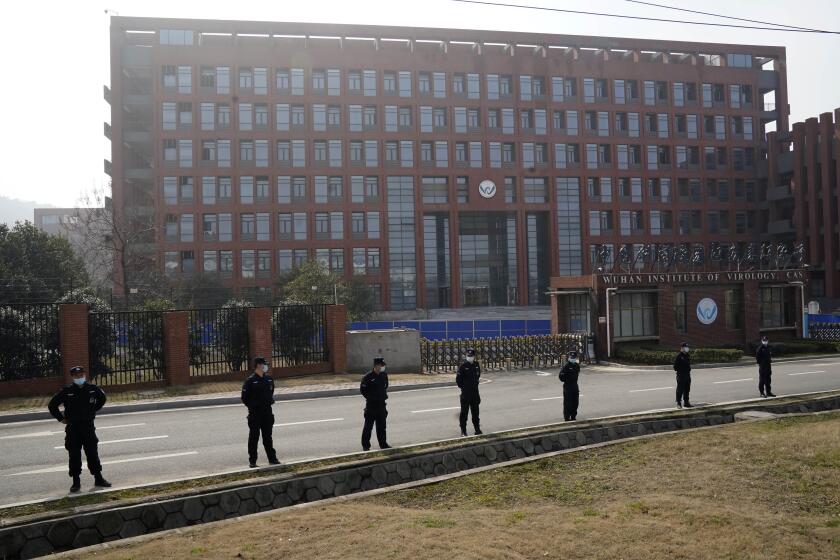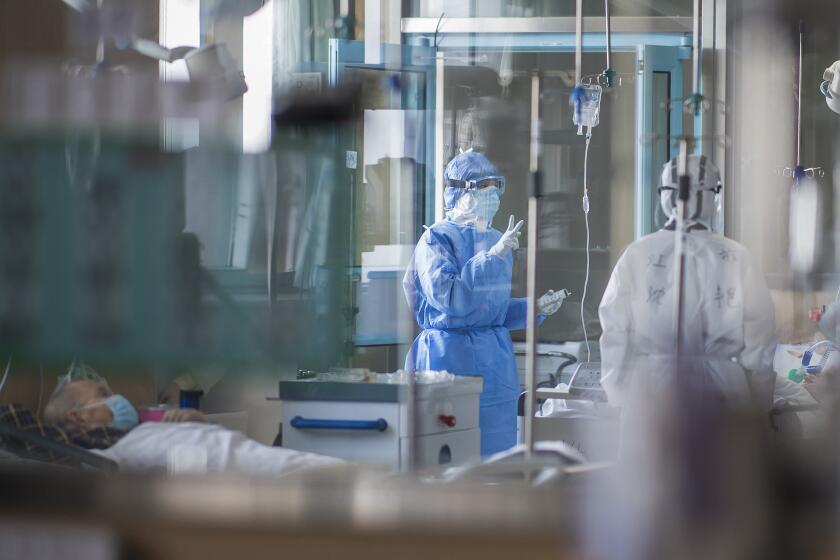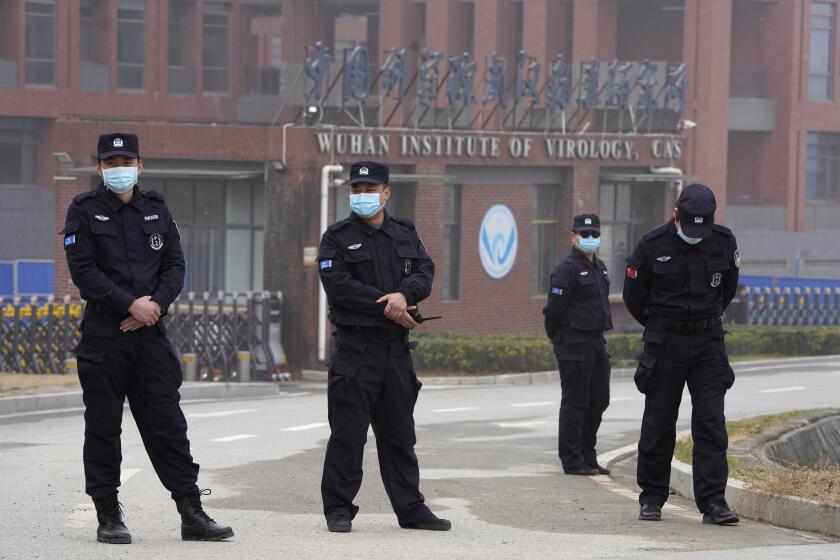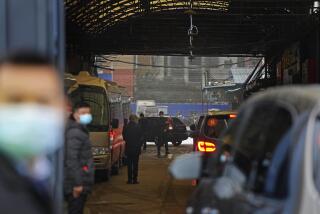New studies say Wuhan market is the only ‘plausible’ source of COVID-19 pandemic
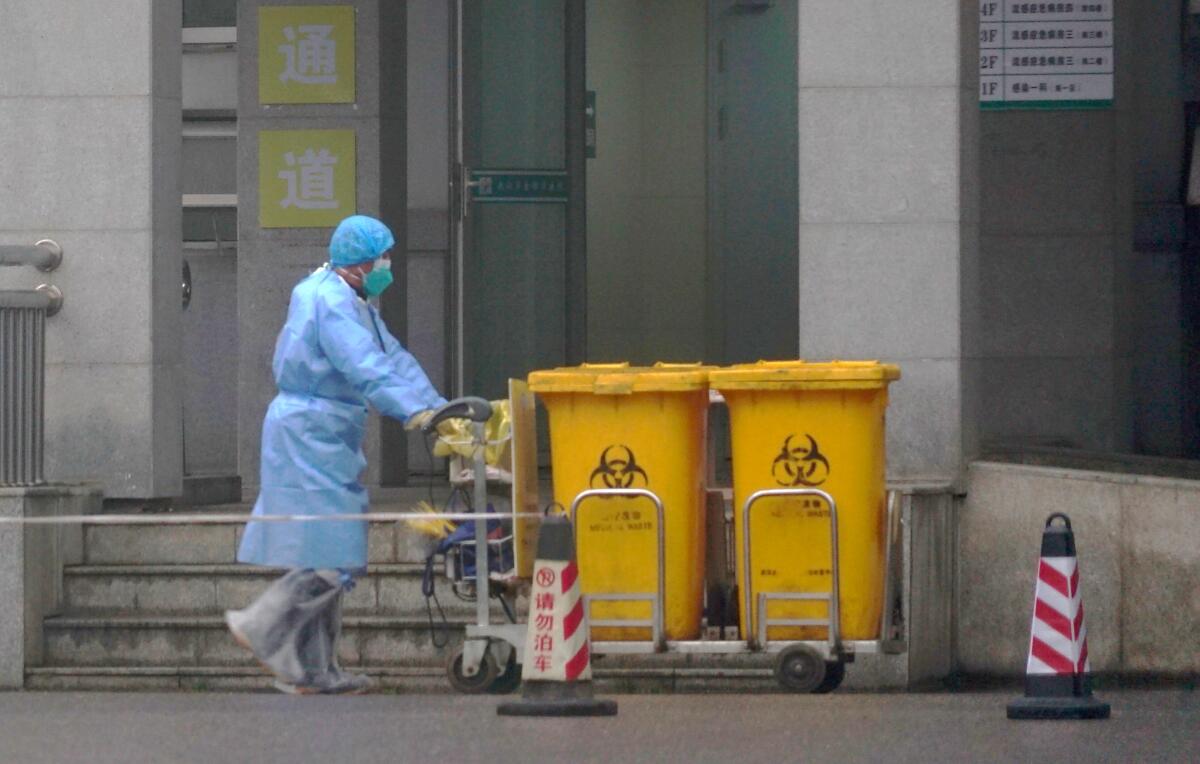
- Share via
Not long after the World Health Organization and China released a report last year dismissing the possibility that the SARS-CoV-2 virus originated in a lab leak, scientists from major research institutions around the world noted the paucity of the published data, and advocated for a rigorous scientific investigation into the pandemic’s origins.
An international team of experts responded to that outcry Tuesday with two complementary papers published in the journal Science. Using different analytical approaches, both papers identify Wuhan’s Huanan Seafood Wholesale Market as the epicenter of the pandemic that has since killed more than 6.4 million people worldwide.
Though the exact species of animal isn’t yet known, the authors conclude that SARS-CoV-2 was most likely present in animals sold at the market in late 2019, and jumped into human workers or shoppers in at least two separate instances.
“In a city covering more than 3,000 square miles, the area with the highest probability of containing the home of someone who had one of the earliest COVID-19 cases in the world was an area of a few city blocks, with the Huanan market smack dab inside it,” Michael Worobey, a University of Arizona virologist who co-authored one of the new studies, said in a statement.
“All this evidence tells us the same thing: It points right to this particular market in the middle of Wuhan,” echoed study co-author Kristian Andersen of the Scripps Research Institute in San Diego.
“Any other version — a lab leak, for example — would have to explain all this other evidence, and in my view,” he added, “that’s just not plausible.”
In the early days of the pandemic, before SARS-CoV-2 had circulated widely in the U.S., Andersen wrote to Dr. Anthony Fauci, director of the National Institute for Allergy and Infectious Diseases, expressing concern that the new virus had features of being engineered by humans.
Scientists are urging their colleagues to dig deeper into the origins of the coronavirus behind the pandemic, including the possibility of a lab escape.
As the research evolved, so did his thinking.
“I was quite convinced of the lab leak myself until we dove into this very carefully and looked at it much closer,” Andersen said. “Actually, the data points to this particular market.”
Worobey also has had his doubts about the Huanan market origin story. He was one of 18 experts who published an open letter last year in the journal Science that lobbied for a more thorough investigation into the possibility that the virus had inadvertently escaped from a research laboratory.
“I’ve seen no evidence that I can look at and say, ‘Oh, OK, this certainly refutes the accidental lab origin and makes it virtually 100% certain that it was a natural event,’” he said at the time. “Until we’re at the stage, both possibilities are viable.”
Worobey went on to conduct a detailed accounting of the earliest cases of what was then considered a pneumonia of unknown origin. He reported in Science that a 41-year-old accountant who had been flagged as the first COVID-19 patient on Dec. 8 actually had a fever due to dental surgery. The accountant appeared to have contracted the coronavirus eight days later, but that was days after a seafood vendor from the Huanan market sought treatment for what was probably COVID-19.
A close analysis of Wuhan’s earliest COVID-19 cases points to a live-animal market as the most likely source of the novel coronavirus, a study argues.
The teams behind the new studies consisted of more than 30 researchers from 20 different institutions around the world. They divided their work broadly into two parts: one tracing the virus’ initial appearance in animals and people, the other analyzing genomic data from the earliest cases.
In the first study, the team was able to analyze the location of nearly all COVID-19 cases identified by WHO in December 2019, 155 of which were in Wuhan. The sickest patients in that first month of the outbreak were all clustered around the market.
By January and February, as the virus spread, the highest concentrations of infections moved from the neighborhood surrounding the market to the city’s most densely-populated areas.
Furthermore, swabs taken from surfaces in the market itself were significantly more likely to come back positive from cages and stalls selling live animals vulnerable to the coronavirus, including red foxes and raccoon dogs. Those animals were likely infected from bats or other farm animals known to harbor the coronavirus.
The second study looked at the genomic sequence of the virus in the pandemic’s early days. Researchers identified two distinct SARS-CoV-2 lineages, which suggests that the virus leapt into the human population in two separate instances.
“Before embarking on this research, we were very unclear on how lineage A and lineage B related to each other, and if they both had occurred in or around the Huanan market,” said Dr. Marc Suchard, a biostatistician at UCLA Fielding School who worked on the study. The data showed that both versions of the virus circulated at the market, suggesting there were at least two separate cases of successful virus transmission from animals to humans. “It’s approximately 60 times more likely that you have multiple introductions,” Suchard said.
A timeline of COVID-19’s early weeks in China, beginning with the emergence of the first patient on or around Nov. 18.
The studies are an indirect response to a WHO-commissioned report on the pandemic’s origins that was published in March 2021. Using data supplied by China, the report ranked four possible scenarios for the pandemic’s genesis from “extremely unlikely” to “very likely.”
That report identified the most likely cause of the pandemic as a viral leap from a host species to humans via an intermediary animal. An accidental release of virus from the Wuhan Institute of Virology or another laboratory was deemed least likely.
The other two theories studied included a direct jump from an animal host to a human (“possible to likely”) and surface transmission from frozen food products (“possible”).
Almost as soon as the report was published, scientists around the world expressed concern. In May 2021, Science published the open letter from Worobey and researchers at Harvard, Yale, Stanford and other leading institutions that called for a more thorough investigation.
It wasn’t that the report’s conclusions seemed implausible, they argued. The problem, scientists wrote, was that the report didn’t appear to offer enough solid evidence to support any conclusion at all.
“On all accounts, it was not an adequate, detailed kind of presentation of data that would allow an outside scientist to arrive at an independent conclusion,” Dr. David Relman, a co-author of the letter and professor of microbiology and immunology at Stanford University, told The Times when the letter was published.
The lab-leak hypothesis for COVID-19 is getting lots of attention, but there remains no evidence for the claim that COVID-19 originated in a laboratory in China or anywhere else.
WHO Director-General Tedros Adhanom Ghebreyesus appeared to share similar concerns upon the report’s publication, offering up the global organization’s resources to pursue a more robust investigation.
“Although the team has concluded that a laboratory leak is the least likely hypothesis, this requires further investigation,” he said in a speech to member states. “Let me say clearly that, as far as WHO is concerned, all hypotheses remain on the table.”
A follow-up report released last month by a group of experts convened by WHO said more work was still needed to understand whether the pandemic could have been sparked by a laboratory accident.
Irrefutable proof is harder to come by in biology than in a field like math or physics, Andersen cautioned. Yet he and his fellow co-authors who previously considered the lab leak hypothesis said they feel the evidence currently available points solidly in one direction.
Worobey agreed. The evidence he and his colleagues published Tuesday, he said, “has moved me to the point where now I also think it’s just not plausible that this virus was introduced in any other way than through the wildlife trade at the Huanan market.”
